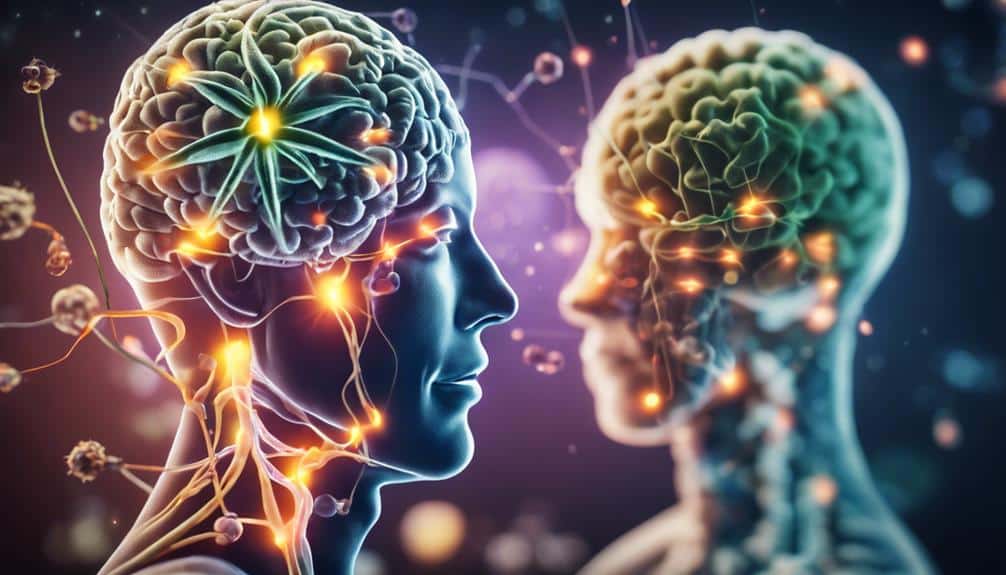Think of your body as a finely-tuned orchestra, with the endocannabinoid system acting as the conductor, ensuring harmony between all the different instruments or body systems.
Now, consider introducing cannabis into this symphony. You’re probably curious about what happens next, aren’t you? How does cannabis interact with this system and what impact does it have on your health?
Well, let’s unveil and explore this fascinating and complex interaction. But be warned; it’s not as simple as you might think.
Understanding the Endocannabinoid System

To fully comprehend the impact of cannabis on human health, you must first understand the workings of the endocannabinoid system—a complex cell-signaling system that plays a crucial role in maintaining physiological homeostasis. This system has evolved over time to interact seamlessly with natural substances like cannabinoids found in cannabis.
A critical aspect of this system’s function is its role in maintaining a balanced internal environment or homeostasis. When this balance is disrupted due to factors such as stress, poor diet, or lack of sleep, it can lead to an endocannabinoid deficiency. This deficiency may manifest as various health issues including mood disorders, chronic pain, and inflammatory conditions.
Research suggests that therapeutic use of cannabis can help address endocannabinoid deficiency by supplementing the body’s natural cannabinoid levels—thereby assisting the endocannabinoid system in restoring balance.
Understanding the endocannabinoid system and its evolution is crucial for those desiring to serve others through healthcare or wellness initiatives. It’s an essential step in leveraging the therapeutic potential of cannabis, thereby supporting the overall health and wellbeing of those you serve.
Key Components of the Endocannabinoid System
Diving deeper into the endocannabinoid system, you’ll find it’s a complex network made up of three key components: endocannabinoids, receptors, and enzymes.
- Endocannabinoids: These are naturally produced chemicals in your body, similar to cannabinoids found in cannabis. Factors affecting your body’s endocannabinoid production include diet, exercise, and stress. These ‘Endocannabinoid Production Factors’ can directly influence your mood, pain sensation, and overall health.
- Receptors: Found throughout the body, endocannabinoid receptors are essential for your body to react to endocannabinoids—whether they’re produced naturally or introduced externally. The two main receptors are CB1—predominantly in the nervous system—and CB2—mainly in immune cells.
- Enzymes: After endocannabinoids have done their job, enzymes break them down. These enzymes help maintain balance in your endocannabinoid system and prevent overstimulation.
Understanding these components is crucial for identifying ‘Endocannabinoid System Disorders’. These disorders—which can result from a malfunction in any part of the system—can affect a wide range of bodily functions from sleep and appetite to mood and memory. By understanding these key components, you’re better equipped to serve others on their journey towards optimal health.
How Cannabis Interacts With the Endocannabinoid System

When you consume cannabis, its cannabinoids interact with your endocannabinoid system in a variety of impactful ways, profoundly influencing your health and well-being. The endocannabinoid system—which exists naturally in your body—responds to these plant-based cannabinoids, guiding them towards the cannabinoid receptors that play a crucial role in maintaining balance and harmony within the body.
These receptors—called CB1 and CB2—are scattered throughout your body, concentrating in the brain and immune system respectively. Depending on the strain of cannabis you consume, the effects on these receptors can vary—hence the term ‘Strain Specific Effects’. Some strains are high in THC—the psychoactive component that binds primarily with CB1 receptors in the brain—producing the ‘high’ commonly associated with cannabis use. Others are rich in CBD—a non-psychoactive compound that interacts more with CB2 receptors—providing potential therapeutic benefits without a ‘high’.
Understanding this interaction is vital if you’re considering cannabis use for health purposes. It enables you to choose the right strain for your specific health needs—and importantly—to use it in a way that best serves your overall well-being.
Potential Health Benefits of Cannabis
Exploring the health benefits of cannabis, you’ll find a range of potential therapeutic effects largely due to its interaction with our body’s endocannabinoid system. Cannabis—particularly its components like CBD—can provide an effective alternative to traditional pharmaceuticals, with fewer side effects.
Here are three key health benefits:
- Cannabis for Pain Relief: Cannabis has been lauded for its analgesic properties. It works by altering pain perception pathways in the brain, providing relief from chronic pain and conditions such as arthritis and fibromyalgia.
- CBD’s Anti-Inflammatory Properties: CBD—a non-psychoactive component of cannabis—has potent anti-inflammatory effects. It’s been studied for conditions like inflammatory bowel disease and rheumatoid arthritis.
- Mental Health Benefits: Cannabis may help reduce symptoms related to PTSD, anxiety, and depression. It’s a promising area of research, with users reporting improved mood and relaxation.
Risks and Considerations for Cannabis Use

While cannabis offers many health benefits, it’s important to consider the potential risks and implications of its use. The addiction potential of cannabis is one such risk. Although it’s less addictive than some substances, habitual cannabis use can lead to dependency which can subsequently impact your daily life, relationships, and overall well-being.
Moreover, the potential mental health effects of cannabis shouldn’t be overlooked. Research shows that heavy prolonged cannabis use can exacerbate symptoms in individuals with pre-existing mental health conditions such as anxiety and depression. There’s also evidence suggesting that it can precipitate the onset of schizophrenia in people predisposed to the disorder.
In addition, while cannabis can provide relief for certain physical ailments, it can also have adverse effects on physical health. These can include respiratory problems—especially when smoked—and potential harm to the developing brains of adolescents.
Conclusion
So, you’ve delved into the complexities of the endocannabinoid system, discovered how cannabis interacts with it, and balanced the potential benefits against possible risks. Quite a journey, isn’t it? While cannabis might offer health benefits, it’s important to remember that it also comes with precautions. Now that you’ve grasped the science, you’re in a position to make educated decisions about cannabis use. It’s your body and your health after all—knowledge is power, right?
I’d like to personally invite you to learn more about the fascinating world of cannabis and its impacts on your health. Come visit us at Cannabis Docs of Delaware—we’d love to answer your questions and provide any guidance you may need. Alternatively, you can always give us a call. We’re here to support you on your journey towards understanding and embracing the potential benefits of cannabis. We look forward to hearing from you soon!
The post The Endocannabinoid System Explained: Cannabis’s Impact on Human Health appeared first on Delaware Cannabis Docs.
source https://delawarecannabisdocs.com/the-endocannabinoid-system-explained-cannabiss-impact-on-human-health/

No comments:
Post a Comment